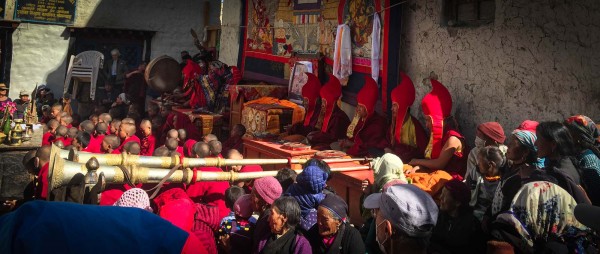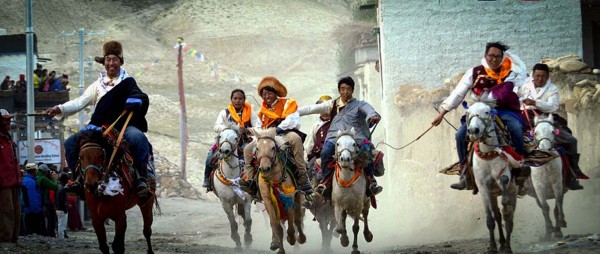Important Information
Region
Mustang Region Treks
Duration
28 Days
Max Altitude 5595 Meters
Best Season Spring & Autumn
Activity Per Day
4-5 Hours Walk
Grade
Level 4
Group Size
2 - 12 people
Transportation Bus/Flight/Jeep
The Teri La Pass Trek is located in the eastern Upper Mustang of Damodar Himal close with the border of Tibet Autonomous Region of China. This trek is linked with two different districts of Mustang and Manang. Teri La Pass (5,595m) Trek was discovered in 2006 and used by salt traders in the past to trade between the natives of Lo Kingdom (Upper Mustang) and Nar Phu valley. This trek lies under the restricted area of Nepal where you need the special permit of Nar Phu and Upper Mustang from the Immigration Department of Nepal. Himalayan Wander walkers will prepare your necessary permits and organize this trip with the latest updates of all routes.
Teri La Pass is one of the most challenging trekking destinations in Nepal. This trek needs a full camping trek where you will experience the real adventure crossing the high remote passes and away from the remote villages for a week-long with the silence of nature. This is truly an adventure trek to explore the diverse landscape from lower mustang to Manang via Upper Mustang, High passes, isolated moraine, and hidden valley of Nar Phu. Every day of a trek offers you stunning views of the uniquely structured landscape and even magnificent vistas of giant mountains such as the Dhaulagiri range, Annapurna range, Damodar Himal, Tilicho, Gangapurna, and its neighboring peaks. The best time to visit Teri la Pass is from late April to late October.
Teri La passes Trek route:
Teri la Pass Trek route can be done in both ways like anti-clockwise and clockwise. But here you will find a clockwise route itinerary. This Trek starts from Chuksang village of Mustang district and finishes in Besisahar of Lamjung district, the starting point of the Annapurna circuits trek. On the next day of your arrival in Nepal, you will have city sightseeing when we prepare your trekking permits. The actual trip kicked off by driving to Pokhara and flight to Jomsom. Trekking starts from Chhusang to Lo-Manthang via Giling, Ghami, and Gar Gompa. After exploration day in lo-Manthang, you will head to the eastern Upper Mustang of Yara and Tangye villages. After spending a fine day at Tangye your camping trek begins and lasts for a week to reach another village of Nar in the Manang region. After visiting Nar Phu valley continue to Koto and drive to Kathmandu. During this trek, you will mostly encounter Tibetan culture and Buddhist religious memorials like Chortens, monasteries, Mane wall, and Shrines within the villages.
If you are looking for a different itinerary than the itinerary here please Customize Your Trip
Include
Arrivals and departure transport by car (We will collect you from the Kathmandu international airport) and transfer to Hotel.
Half-day sightseeing in Kathmandu (Boudhanath and Pasupatinath) with city guide and necessary transport.
1 Night Hotel in Pokhara
3 nights’ accommodation (2 persons per room) in Kathmandu in a 3* standard Hotel with breakfast.
Pokhara - Jomsom flight ticket.
All land transportations (a private car/bus)
Full Camping trek with all meals and hot drinks during the trek serve by Cook and staff. Tented accommodation with dining, table, chairs, toilet tent, and shower tent. Salary, insurance, food, accommodation for guides, and porters. Supporters’ staff, cook, porters.
Upper Mustang special permits ($500), Nar Phu Special permits, and national park entry permits.
Group First Aid Kit.
Company Duffle Bag for luggage
Exclude
Meals & drinks during the trek and in Kathmandu (unless stated otherwise under ‘The trip cost includes’)
Personal trekking equipment
Travel/medical insurance
Emergency rescue evacuation
Phone calls
Internet
International air ticket
Tips for your trekking guide & porters at the end of the trek
If you’re forced to extend your trek due to bad weather or natural disaster circumstances, we are not liable to pay any compensation or otherwise be responsible for any expenses you may incur
Anything not mentioned in the ‘includes section’
Nepal entry visa Fee.
Important Information
CHECKLISTS
- Valid passport (valid for six months from the date of your trip)
- One other picture ID, such as driver’s license (in case of emergency and for use as a substitute of passport or in case of loss of your passport) Photocopy of passport page to carry in a wallet
- Air tickets (Make a copy of flight tickets which may be helpful, in case of loss)
- Visa Clearance (Make a copy of visa clearance which may be helpful, in case of emergencies)
- MasterCard, Visa Credit, and Debit Cards are accepted in Nepal. However, traveler's cheques and some cash are highly recommended.
- Mobile (if your cell phone is from CINGULAR USA or ATNT (USA) operators then your cell phone will work in Nepal.)
Guiding, Food, and Camping
In Nepal, all trekking supplies - camping equipment, kitchen implements, food - are all carried by pack animals like mules, Yaks, and horses. Even Porters are common in Nepal. All trekkers are accompanied by a guide, a cook, and usually at least one horseman or yak herder. With the surest footing; they lead trekking groups across the passes. The horseman and cook will usually run ahead during a trekking day. They will have prepared a packed lunch for hikers and will go on to the night’s resting place to set up camp. They set up tents, cook dinner, and ready the area for arriving trekkers. When trekkers reach the campsite they are greeted with a hot cup of tea and biscuits in the dining tent. After six hours in the mountains, no drink will ever taste sweeter. For dinner, the cook will usually prepare a buffet of dishes that are as welcome as they are delicious.
DRESS CODE FOR VISITING MONASTERIES, AND TEMPLES IN NEPAL
- Shirt (either half or full sleeve)
- Full pants/long skirts
- Any type of shoes with socks
- No Hats, No Umbrella, No Slippers, No t-shirts, No short skirt, and No half-pants
- Photographs allowed in the courtyard only.
Note regarding itineraries
Although we generally adhere to the schedule, the itinerary is subject to change for numerous reasons beyond our control, including weather and terrain conditions, suitable campsite availability, and the group's general fitness level. It is important to understand that our trek is logistically complex and it is not unusual that adjustments be made. Our guide will orient you each evening to the following day's plan; their good judgment is the key to the long history of successful treks that Himalayan Wander Walkers has led till now. Please remember that our ability to make adjustments as needed helps to ensure that your trek is successful.
Frequently Asked Question
Yes, the Teri La Pass Trek can be customized to meet your needs. We can modify the itinerary based on your preferences, whether you want to shorten or extend the trek or add extra rest days. If you're interested in specific destinations, such as monasteries or villages, we can adjust the route to include those as well. Just let us know what you're looking for, and we’ll be happy to accommodate your wishes: “Customize Your Trip.”
Altitude sickness can occur in regions above 2,500 meters, and the Teri La Pass trek takes you to elevations of 5,595 (Teri La Pass), so you might face some symptoms of altitude sickness, and acclimatization is important. This tour is designed with rest days to help you adjust. Staying hydrated, avoiding exertion, and listening to your body are essential. If symptoms of altitude sickness occur, your guide will assist in descending to a lower altitude for recovery.
For the Teri La Pass Trek, you need the Upper Mustang special permits ($500), Nar Phu special permits, and national park entry permits, which can be obtained from a government-licensed trekking agency in Kathmandu or Pokhara.
For the Teri La Pass Trek, you need to have sturdy trekking boots, trekking sticks (if you need them), a proper and strong wind cheater, all your medication, along with a water purification pill, sleeping bags, energy bars, hats to block the sun, and proper SPF sunscreen. Read more about trekking gear.
There are various alternatives to Teri La Pass, such as if you want to trek or travel within the Mustang Region, you can do the Tiji or the Yartung Festival, or the Classic or the Jeep tour to Mustang. If you want to do trekking other than in the Mustang region, then you can visit the Annapurna region, Langtang, or the Manaslu Tsum region.
| {{type.min}} - {{type.max}} Pax {{type.name}} - {{type.desc}} | {{type.display_price}} per people |
Extra prices:
Let us help you decide Inquiry
You might also like

- 17 days
- Mustang Region Treks
Tiji Festival in Upper Mustang
Are you looking for local travel agency to organize your Tiji Festival Trek to Upper Mustang in the year 2026 and 2027? The date for Tiji Festival Trek 2026 and 2027 is already updated. The Tiji festival Trek year 2026 will be celebrating on the 14th, 15th and 16th May 2026. According to the...



